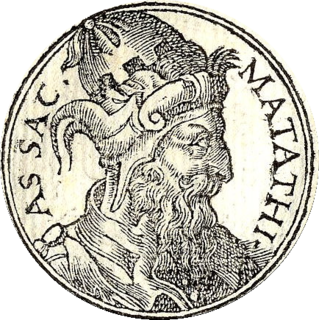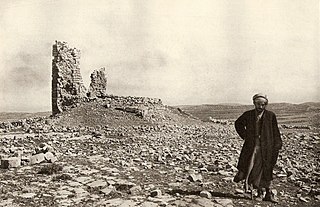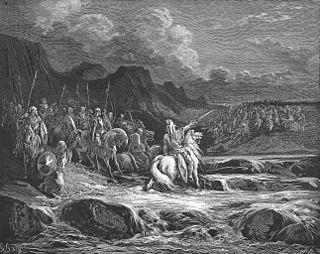This article concerns the period 169 BC – 160 BC.
Year 160 BC was a year of the pre-Julian Roman calendar. At the time it was known as the Year of the Consulship of Gallus and Cethegus and the Fourth Year of Houyuan. The denomination 160 BC for this year has been used since the early medieval period, when the Anno Domini calendar era became the prevalent method in Europe for naming years.

The Maccabees, also spelled Machabees, were a group of Jewish rebel warriors who took control of Judea, which at the time was part of the Seleucid Empire. They founded the Hasmonean dynasty, which ruled from 167 BCE to 37 BCE, being a fully independent kingdom from about 110 to 63 BCE. They reasserted the Jewish religion, partly by forced conversion, expanded the boundaries of Judea by conquest and reduced the influence of Hellenism and Hellenistic Judaism.

The Hasmonean dynasty was a ruling dynasty of Judea and surrounding regions during classical antiquity, from c. 140 BCE to 37 BCE. Between c. 140 and c. 116 BCE the dynasty ruled Judea semi-autonomously from the Seleucid Empire, and from roughly 110 BCE, with the empire disintegrating, Judea gained further autonomy and expanded into the neighboring regions of Samaria, Galilee, Iturea, Perea, and Idumea. The Hasmonean rulers took the Greek title "basileus", and some modern scholars refer to this period as an independent kingdom of Israel. The kingdom was ultimately conquered by the Roman Republic and the dynasty was displaced by Herod the Great in 37 BCE.

The First Book of Maccabees, also known as First Maccabees, is a book written in Hebrew by an anonymous Jewish author after the restoration of an independent Jewish kingdom by the Hasmonean dynasty, around the late 2nd century BC. The original Hebrew is lost and the most important surviving version is the Greek translation contained in the Septuagint. The book is held as canonical scripture by the Catholic, Orthodox, and Oriental Orthodox churches, but not by Protestant denominations nor any major branches of Judaism; it is not part of the Tanakh. Some Protestants consider it to be an apocryphal book.

Judah Maccabee was a Jewish priest (kohen) and a son of the priest Mattathias. He led the Maccabean Revolt against the Seleucid Empire.

The Battle of Beth Zechariah was a battle around May 162 BC during the Maccabean revolt fought between Jewish rebels under the leadership of Judas Maccabeus against an army of the Seleucid Empire, the Greek successor state (diadochi) to the Macedonian conquests that controlled Syria and Babylonia. The battle was fought at Beth Zechariah and was a Seleucid victory, with the rebels driven from the field in retreat. Judas's brother Eleazar Avaran died in combat with a war elephant. The defeat allowed the Seleucids to continue their campaign and besiege the Jewish holy city of Jerusalem.

The Battle of Elasa was fought in April 160 BCE during the Maccabean Revolt between Judean rebels led by Judas Maccabeus and an army of the Seleucid Empire under the command of Bacchides. The battle resulted in the triumph of the Greek Syrian forces, the defeat of the Maccabees, and the death of Judas Maccabeus.

The Battle of Emmaus took place around September 165 BC between the Maccabee forces of Judean rebels, led by Judas Maccabeus, and an expedition of Seleucid Empire forces under generals Gorgias, Ptolemy the son of Dorymenes, and Nicanor near Emmaus. The battle was won by the Maccabee rebels, who marched by night and surprised the Seleucid camp while many soldiers were absent.
The Books of the Maccabees or Sefer Hamakabim, Book of the Maccabees, recount the history of the Maccabees, the leaders of the Jewish rebellion against the Seleucid dynasty.

Jonathan Apphus was one of the sons of Mattathias and the leader of the Hasmonean dynasty of Judea from 161 to 143 BCE.
Alcimus, also called Jakeimos, Jacimus, or Joachim (Ἰάκειμος), was High Priest of Israel for three years from 162–159 BCE. He was a moderate Hellenizer who favored the ruling government of the Seleucid Empire and opposed the Maccabean Revolt which was in progress at the time.

Mattathias ben Johanan was a Kohen who helped spark the Maccabean Revolt against the Hellenistic Seleucid Empire. Mattathias's story is related in the deuterocanonical book of 1 Maccabees. Mattathias is accorded a central role in the story of Hanukkah and, as a result, is named in the Al HaNissim prayer Jews add to the Birkat Hamazon and the Amidah during the festival's eight days.

The Battle of Beth Horon or Battle with Seron was fought at some point between Spring 166 BC to Spring 165 BC during the Maccabean Revolt between Judean rebels led by Judas Maccabeus and an army of the Seleucid Empire under the command of Seron, described as "commander of the Syrian army". Beth-Horon, or Bethoron, was a strategic mountain pass leading from the coastal plain to the Judean hill country. Utilizing guerrilla warfare tactics, the Maccabee rebels ambushed the passing Seleucid force from the pass, pursuing the surprised and fleeing remnants into the plain.
The Battle of Adasa was fought during the Maccabean revolt on the 13th of the month Adar, 161 BC at Adasa, near Beth-horon. It was a battle between the rebel Maccabees of Judas Maccabeus and the Seleucid Empire, whose army was led by Nicanor. The Maccabees won the battle after killing Nicanor early in the fighting. The battle came after a period of political maneuvering over several months where the peace deal established a year earlier by Lysias was tested by new High Priest Alcimus, new military governor Nicanor, and Maccabee leader Judas Maccabeus.

The Battle of Beth Zur was fought between the Maccabees led by Judas Maccabeus and a Seleucid Greek army led by Regent Lysias in October 164 BC at Beth Zur. According to the books of Maccabees, the rebels won the battle, although how significant this victory really was is disputed; it is possible the battle's result was inconclusive. Through a stroke of good fortune for the rebels, the days after the battle likely coincided with news of Seleucid King Antiochus IV Epiphanes's death reaching Judea; rather than continue the campaign, the Seleucid army and Lysias returned to the capital to handle the leadership transition. The Maccabees were able to capture Jerusalem soon after.

The Acra is both the name of a fortified structure and also one of three residential areas in Jerusalem during the late Second Temple period from which it takes its name. This area, also known as the "Lower City", corresponds today with Silwan and the City of David, along with its sister part of "The Upper Market", also known as the "Upper City", and the newer suburb known as Bezetha. Acra is the shortened-form of the Greek loanword akrópoli, adopted in Aramaic usage and having the connotation of "citadel" or "stronghold", a place thought to have once had a fortified compound built by Antiochus Epiphanes, ruler of the Seleucid Empire, following his sack of the city in 168 BCE. The capture of the Lower City (Acra) played a significant role in the formation of the Hasmonean Kingdom, and in the Maccabean Revolt when the city was captured by Judas Maccabeus and the fortress destroyed by Simon Thassi. In the center of this part of the city lay the Pool of Siloam.

Eleazar Avaran, also known as Eleazar Maccabeus, Eleazar Hachorani/Chorani was the fourth son of Mattathias and the younger brother of Judas Maccabeus. He was killed at the Battle of Beth-zechariah during the Maccabean revolt.

The Maccabean Revolt was a Jewish rebellion led by the Maccabees against the Seleucid Empire and against Hellenistic influence on Jewish life. The main phase of the revolt lasted from 167–160 BCE and ended with the Seleucids in control of the country, but conflict between the Maccabees, Hellenized Jews, and the Seleucids continued until 134 BCE, with the Maccabees attaining independence by the end. King Antiochus IV Epiphanes launched a massive campaign of repression against the Jewish religion in 168 BCE. The reason he did so is not entirely clear, but it seems to have been related to the King mistaking an internal conflict among the Jewish priesthood as a full-scale rebellion. Jewish practices were banned, Jerusalem was placed under direct Seleucid control, and the Second Temple in Jerusalem was made the site of a syncretic Pagan-Jewish cult. This repression triggered exactly the revolt that Antiochus IV had feared, with a group of Jewish fighters led by Judas Maccabeus and his family rebelling in 167 BCE and seeking independence. The rebels as a whole would come to be known as the Maccabees, and their actions would be chronicled later in the books of 1 Maccabees and 2 Maccabees.

During the Maccabean Revolt against the Seleucid Empire, there were a series of campaigns in 163 BC in regions outlying Judea - Ammon, Gilead, Galilee, Idumea, and Judea's coastal plain, a wider region usually referred to as either Palestine or Eretz Israel. The Maccabee rebels fought multiple enemies: Seleucid garrisons and hired mercenaries under a commander named Timothy of Ammon, non-Jewish inhabitants hostile to the Maccabees and their Jewish neighbors, and possibly the Tobiad Jews, a clan that generally favored the ruling Seleucid government. During 163 BC, the main Seleucid armies composed of Greeks were elsewhere, so the Maccabees were free to expand their influence against their neighbors.














